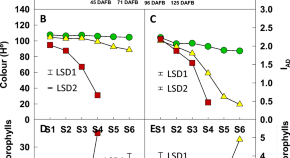An Insight into the Hormonal Interplay Regulating Pigment Changes and Colour Development in the Peel of ‘Granny Smith’, ‘OPAL®’ and ‘Royal Gala’ Apples
Authors (first, second and last of 4)

Collection
Fruit ripening requires the coordinated expression of several genes. Fruit traits as post-harvest characters like color, aroma, softening, sugar content, and healthy compounds are very important for consumers. Key genes trigger changes at molecular level involving several different metabolic pathways which interact in a single or multiple way. For example, color or healthy compounds are synthesized through flavonoid or terpene pathways which influence not only fruit attractiveness, but also increase antioxidant capacity. In this sense, secondary metabolites (healthy compounds) can contribute to preventing human diseases. In addition, softening or sugar content is controlled by the participation of different enzymes in a coordinated manner, and most of them take part in degrading hydrocarbon polymers from the extracellular matrix. Finally, aroma is generated by the metabolization of amino acids, sugar intermediates and alcohols, producing lineal or ramified volatiles compounds enhancing fruit attractiveness.
Key genes of all these metabolic pathways are regulated in their expression by transcription factors which synchronize and modulate phenotypic changes making fruits more attractive for consumers. The process is highly regulated by plant hormones and clearly different for climacteric and non-climacteric species. Importantly, the knowledge on epigenetic factors regulating fruit development and ripening has increased in the last years, making this a very interesting research area.
University of Talca, Chile
Foundation Edmund Mach, Italy











